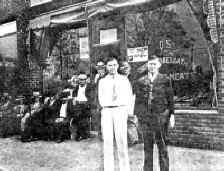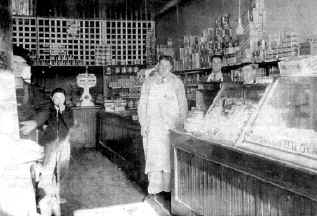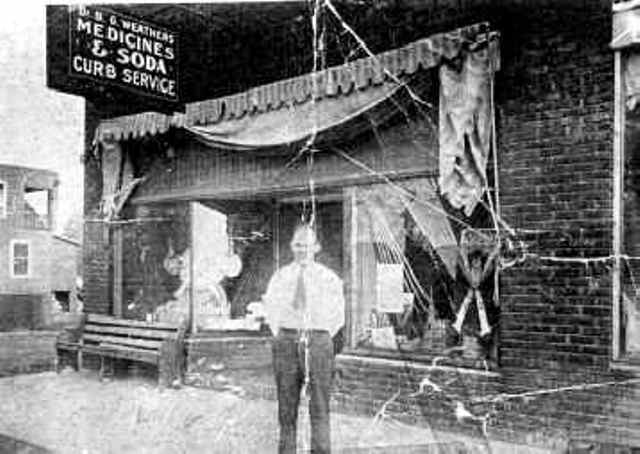


















|
Early 1900's
      
The 1930's and Depression Years
Farm Life
During the late 1920's and the 1930's the whole country, with Stanley included, was going through the
"Great Depression."
Farming remained the major occupation in the Stanley area, even though some people had left the farm
to go to work in the mills. They moved into town and made their homes close to the mill.
The countryside consisted of large family farms or smaller tenant farms where people lived off the
land as the ancestors had before them. Life was hard and being conditioned to the killing of animals
for food and working in the fields were still the necessities of life.
Highway Expansion Continues
Back in 1922-23 the Highway Department had begun a program to pave most of the major roads in the
state. At that time the road from Charlotte to Lincolnton was paved as well as the road from Stanley
to Dallas. However, by 1929 it was determined that a new and better road from Stanley to Mt. Holly
was needed. A roadbed was graded for the new route which entered Stanley directly alongside the
railroad and eliminated two dangerous curves upon entering town.
Telephone Exchange
In December of 1930 Lester T. Lineberger was allowed a 33 year franchise to build and operate a telephone
exchange in the town of Stanley. However, on the 7th day of July 1941 an authorization was afforded
the Southern Bell Telephone Company of Atlanta, Georgia to erect telephone and telegraph lines in the
town of Stanley.
No Town Taxes
No property taxes were levied for the year 1933 in Stanley.
George Robert Shook
Bob and Margaret Shook moved to Stanley around 1904 following his parents and brothers
and sisters who had moved from Catawba County. Bob and Margaret only lived here a short while
before moving with his young family to Pumpkin Center where he ran a grocery store; and then a while
later the family moved to Maiden. In 1925 Bob Shook purchased the meat market in Stanley from Logan
H. Goodson and the family moved back to Stanley.
He ran the meat market for only a short while and then began selling groceries in the store near the
Lutheran Church that had been previously run by James S. Fox and his wife, Mary A. Wallace Fox.
 |
| Warren Abernathy on the left and Bob Shook on right in front of
Shook-Abernathy Grocery Store on North Main Street around early 1930's |
Sometime in the early 1930's Bob Shook went into partnership with Warren
Abernathy in a grocery
store Warren began in February of 1928. This store was located north in the next block, beside McKelvey's
Drugs.
After Warren Abernathy's death at age 32 on 29 November 1934, Paul Shook, Bob's brother, went into
the grocery business with him. Some time later they moved their grocery business a block south into the
McLurd building next to the Post Office. At age 72 Bob sold his share in the business to his brothers but
continued to work at the store without pay until around age 94.
The Bob Shook family attended Christ's Lutheran Church where he was responsible for ringing the
church bell, which he did every Sunday for forty three years until the new sanctuary was built and they no
longer had the bell.
In 1975 the town of Stanley declared September 5th as Mr. Bob Shook Day. It was his 100th
birthday.
George Robert Shook died at the age of 102 on 23 October 1977. He and his wife, Margaret, are buried
in Christ Lutheran Church Cemetery.
 |
Inside the Store on North Main Street
Paul Shook in apron - Avery Shook behind counter (without
hat). Others unidentified. |
Bob Shook's brother, Paul was a merchant in Stanley for over fifty years, both in the grocery and
later in the clothing business.
During the Depression, when the people didn't have money to buy groceries, he let them have what they
needed on credit, sometimes knowing that many may not be able to pay him later. A lot of families who
would have gone hungry during the Depression were able to be fed thanks to Paul and his help. Not
only did he give away large amounts of goods to private families, but also to Stanley Schools, the
Salvation Army and to his Church. (See George Robert Shook and
Paul and Edna Shook)
|
Bank Closings
The year 1933 seemed to be the crises year for the Depression. By 2 March 1933 more than 20 states had
declared bank holidays as a measure to stop customers from withdrawing their money in a panic. In a few
days banks across the country were all closed. The Farmer's and Merchants Bank in Stanley was included
in the closing.
An emergency banking bill was drawn up by the Federal Government in which Federal Reserve Notes were issued
to the banks which proved to be in sound condition, allowing them to reopen.
Stanley's Farmers and Merchants Bank never reopened. Many of Stanley's citizens lost money as depositors
as well as stockholders.
A Water and Sewer System for Town
A referendum was held and an ordinance was passed on November 22, 1933 for an issuance of bonds for a
sanitary sewer system, sewage treatment plant and water works system in the town of Stanley. The
waterworks system comprised of deep wells and pump stations at different locations around town as
well as an elevated storage tank. Up until that time most townspeople had private wells and private outdoor
closets or priveys. The mill village residents relied on the mill to supply their water.
The water system, installed first, was completed in 1936 with a water tank constructed on the northern
end of town. The sewer system was not completed until the late 1940's.
Dr. B. G. Weathers, Sr.
A well known figure around town beginning in 1929 was that of Stanley's "country doctor," Dr. Bailey
Graham Weathers, Sr. (1895-1974). His career in Stanley spanned forty-five years and covered a
fifteen mile radius. During World War II he was the only doctor in Stanley. He was on call twenty-four hours a day seven days a week. Very few roads in the county were paved and the doctor expected
to be hauled out of mud holes at almost every farm house where he made a winter call.
During those first twenty years when there were few cars Dr. Weathers estimated he covered 450,000
miles of mostly dirt roads and wore out nine automobiles. He delivered three thousand babies.
In 1949, Dr. Weathers was named Gaston County's "Country Doctor" of the year by the Gaston County
Medical Society. In an interview with the Gastonia Gazette Dr. Weathers was quoted as saying,
"I made up my mind to be a country doctor. That is what I wanted when I started out and I've never
changed my mind."
(See Dr. B. G. Weathers, Sr.)

| To the left is a photo of Dr. Weather's Drug Store taken sometime around 1930.
Pictured in front of the drug store is Forney O. Goodson, Sr. Notice that the sign indicates Dr. B.
G. Weathers Medicines & Soda Shop also had curb service available. |
|
|





